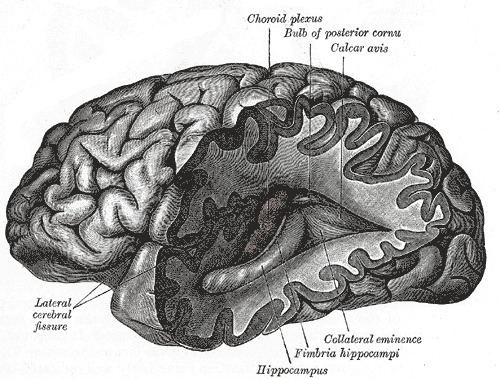 | ||
Developmental cognitive neuroscience is an interdisciplinary scientific field devoted to understanding psychological processes and their neurological bases in the developing organism. It examines how the mind changes as children grow up, interrelations between that and how the brain is changing, and environmental and biological influences on the developing mind and brain.
Contents
- Origins of the discipline
- Tools and techniques employed
- Ground breaking pioneers
- Early trailblazers
- Younger leaders
- References
Developmental cognitive neuroscience is at the boundaries of neuroscience (behavioral, systems, & cognitive neuroscience), psychology (developmental, cognitive, & biobehavioral/ physiological psychology), developmental science (which includes sociology, anthropology, & biology in addition to psychology & neuroscience), cognitive science (which includes computer science, philosophy, dynamical systems, & linguistics in addition to psychology), and even includes socio-emotional development and developmental aspects of social neuroscience and affective neuroscience.
The scientific interface between cognitive neuroscience and human development has evoked considerable interest in recent years, as technological advances make it possible to map in detail the changes in brain structure that take place during development. Developmental cognitive neuroscience overlaps somewhat with fields such as developmental psychology, developmental neuropsychology, developmental psychopathology, and developmental neuroscience, but is distinct from each of them as well. Developmental cognitive neuroscience is concerned with the brain bases of the phenomena that developmental psychologists study. Developmental neuropsychology and developmental psychopathology are both devoted primarily to studying patients, whereas developmental cognitive neuroscience is concerned with studying both typical and atypical development. Developmental neuroscience is devoted entirely to the study of developmental processes in the brain, and primarily during the prenatal period. Developmental cognitive neuroscience, on the other hand, is concerned with interrelations between psychological and biological development. Developmental cognitive neuroscientists study brain development and cognitive, social, and emotional development from the prenatal period through adulthood.
More recently, developmental cognitive neuroscience is interested in the role of genes in development and cognition. Thus, developmental cognitive neuroscience may shed light on nature versus nurture debates as well as constructivism and neuroconstructivism theories. Developmental cognitive neuroscience research provides data that alternately blends together, clarifies, challenges, and causes revisions in developmental, cognitive, and neuroscientific theories.
Origins of the discipline
The origin of the discipline of developmental cognitive neuroscience can be traced back to conference held in Philadelphia in 1989 co-funded by NICHD & NIMH, organized by Adele Diamond, that started the process of developmental psychologists, cognitive scientists, and neuroscientists talking with one another. To bridge the communication gaps, researchers were invited from different fields who were either using the same experimental paradigms to study the same behaviors or were investigating related scientific questions in complementary ways—though they were unaware of one another’s work. They used different words to talk about their work and had different ways of thinking about it, but the concrete, observable behaviors, and the precise experimental conditions under which those behaviors occurred, served to make translation possible. Participants were a small Who’s Who of leaders in developmental science, behavioral neuroscience, and cognitive science. Several new cross-disciplinary collaborations resulted from it, and it is a testament to the value of what came out of the meeting that Oxford University Press tried to acquire the rights to re-issue the book of the meeting’s proceedings 10 years later—The Development and Neural Basis of Higher Cognitive Functions. (The original printing sold out faster than any other New York Academy of Science Annals issue has before or since.)
Developmental psychologists and neuroscientists used to know little of one another’s work. There was so little communication between those fields that for 50 years scientists in both fields were using essentially the same behavioral assay but they did not know it. (Developmental psychologists called the measure the A-not-B task but neuroscientists called it the delayed response task.) In the early 1980s, Diamond not only showed these two tasks showed the identical developmental progression and rely on the same region of prefrontal cortex but through a systematic series of studies in human infants, and infant and adult monkeys with and without lesions to different brain regions. That work was absolutely pivotal in launching the field of developmental cognitive neuroscience because it established the very first strong link between early cognitive development and the functions of a specific brain region. That gave encouragement to others that rigorous experimental work addressing brain-behavior relations was possible in infants. It also fundamentally altered the scientific understanding of prefrontal cortex early in development; clearly it was not silent as accepted wisdom had held.
Mark Johnson's 1997 text Developmental Cognitive Neuroscience was seminal in coining the field's name.
Tools and techniques employed
Absolutely critical to being able to understand brain function in children have been neuroimaging techniques, first EEG & ERPs, then fMRI, and more recently NIRS, MEG, & TMS that look at function and MRI, DTI, & MRS that look at structure, connectivity, and metabolism. Before functional neuroimaging techniques scientists were constrained to trying to understand function from dysfunction (i.e., trying to understand how the brain works from seeing what deficits occur when the brain is damaged or impaired). It is difficult to understate how important technological advances have been to the emerging field of developmental cognitive neuroscience.
